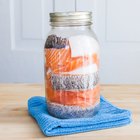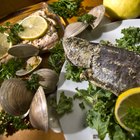
Whether it's been sitting in the fridge for a day or freshly bought, read on to learn more on how to tell salmon shelf life and proper storage techniques.
Shelf Life of Salmon
If you have fresh, raw salmon -- whether steak, fillet or whole -- it will last up to two days in the refrigerator. Cooked salmon will stay good for up to four days, provided you refrigerate it within two hours of cooking. Unopened canned salmon can remain in your pantry for up to five years, while an opened can will last only two days in the refrigerator. Finally, smoked salmon in an unopened vacuum pack will last up to three weeks in the refrigerator, or one week if opened.
Proper Storage
The key to maximizing the shelf life of salmon is proper storage. Fresh, raw salmon should be kept in its original packaging in the refrigerator until you're ready to use it; cooked salmon should be stored in shallow, airtight containers in the refrigerator. Both can be frozen for up to three months; for best quality, wrap the salmon in aluminum foil or plastic wrap, or seal it in a freezer bag to curb freezer burn.
Signs of Spoilage
Changes to the color and texture of the salmon are indicators that it has spoiled. You may even notice a rather slimy, milky coating on the flesh. While fresh salmon should smell like the ocean, spoiled salmon will have a foul, fishy smell. When you touch the flesh of the salmon, it should be firm and spring back; if your finger leaves an indentation, the salmon is old. Finally, whole salmon should have clear, not cloudy eyes.
Thawing Salmon
To preserve your salmon for the long-term, freeze it -- however, proper thawing is essential. Ideally, you should leave your salmon in the refrigerator to thaw overnight; this method maintains the best quality, particularly in terms of texture. If you're in a hurry, put the salmon in an airtight resealable bag and immerse it in cold water, changing the water every 30 minutes until it's thawed. You may also use the microwave, however this method may partially cook some areas of the fish, resulting in a tougher, uneven texture.
Related Articles

How to Grill a Cod Fish

How Long Does Tilapia Last Refrigerated?

Canned Tuna Vs. Fresh Tuna
How to Bake Salmon So It's Tender

How to Cook Frozen, Boneless & Skinless ...

How to Can Salmon Fish

How to Cook Jamaican Jerk Salmon

How to Cook a Salmon Steak in the Oven

How to Cook Salmon in a Steam Bag

Can You Cook Frozen Salmon Whole?

How to Brine a Grilled Salmon

Can I Cut Freezer-Burn Off a Tuna Steak ...
How Long Can Halibut Be Kept Frozen?

Calories in Wild Alaskan Salmon
How to Cook Salmon to Moist & Tender ...

How to Marinate Salmon Fillets
Do Sardines Ever Go Bad?

How to Cook Salmon in Pineapple Juice

Substitutes for a Tuna Steak

Fish Cooking Temperature
References
Resources
Writer Bio
Kelly McCoy has been writing for lifestyle blogs and online publications since 2010, specializing in recipes and techniques for the home cook. She holds a B.A. from Boston University and J.D. from the University of Hastings College of the Law in San Francisco.
Photo Credits
Creatas/Creatas/Getty Images